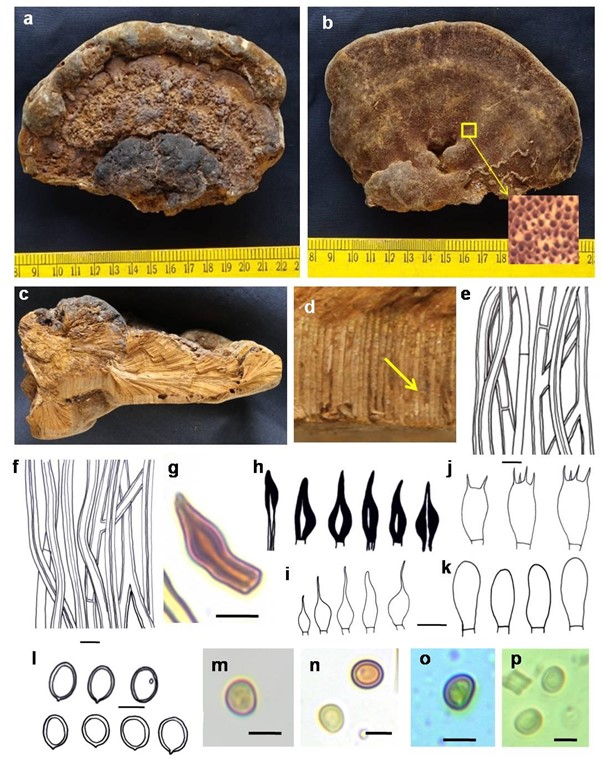Tropicoporus natarajaniae Kaliyaperumal, M., Gunaseelan, S. & Kezo, K., sp. nov. (Fig. 1)
MycoBank number: MB 559816; Index Fungorum: IF 559816; Facesoffungi number: FoF 12715
Etymology: The species epithet “natarajaniae” referring to the Indian Mycologist, Krishnamoorthy Natarajan (1942–2008), for his contributions to the Indian Mycology especially on taxonomic studies in Agaricomycetes.
Holotype: MUBL4020
Diagnosis: Tropicoporus natarajaniae is characterized by velutinate to abundantly tuberculae or warted pilear, uncracked pilear surface, on maturity becoming greyish brown with few cracks only near attachment, Obtuse, velutinate margin and stratified tube with mono-dimitic hyphal system, presence of cystidioles and setae with broadly ellipsoid to subglobose basidiospores.
Description: Basidiocarp perennial, solitary, pileate, sessile, light in weight, hard when dry. Pileus dimidiate, applanate, with no distinct crust, projecting up to 5.4 cm, 6.6 cm wide and 3.6 cm thick near the attachment. Pilear surface on first pubescent to velutinate, smooth with few tuberculae or warts in young basidiomata, uncracked, azonate, yellowish brown (5E5, 5F8) to brown (6E8), on maturation pilei becoming velutinate with abundant tuberculate or warts on the surface, becoming greyish brown (6F3) with few cracks near attachment. Margin entire, obtuse, yellowish brown (5F8). Pore surface brown (6E6) to dark brown (6F6). Pores round to angular, regular, 5–7 per mm. Dissepiments entire, thick. Context duplex with no blackline, up to 1.5 cm, light brown (6D8) to brown (6E7). Tubes 0.7 cm in length, indistinctly stratified, each stratum up to 3 mm brown (6E8)
Hyphal system monomitic in the context and dimitic in the tubes, tissue darkening with KOH without swelling; Context Generative hyphae, thin to thick walled, hyaline to golden yellow, simple septate, rarely branched, 2–5 μm dia.. Trama Generative hyphae, dominant, thin to thick walled, hyaline to pale yellow, septate, occasionally branched, 2–4.8 μm dia.; Skeletal hyphae, thick walled with narrow to wide lumen, yellowish brown, aseptate, unbranched, 2–4.5 μm dia. Hymenial setae dark brown, thick-walled, ventricose to subulate with a sharp or obtuse tip, 6–18.7 × 4.3–5.3 μm. Cystidia absent. Cystidioles hyaline, thin walled, ventricose to fusoid with elongated tapering apical portion, 4.8–27 × 3.8–6 μm. Basidia clavate to sub clavate, 6–18 × 3.8–6.2 μm, with four sterigmata and a simple septum at the base. Basidioles clavate, 4.8–16 × 3.5–6 μm. Basidiospores broadly ellipsoid to subglobose, fairly thick walled to thick–walled, smooth, pale yellow in water, turning golden yellow to brown in KOH, (4.6–) 5–6 (–6.5) × (4.1–) 4.6–4.9 (–5.2) μm (n = 50/2), Q = 1.1 (Q range 1.05–1.3), CB ̄, IKI ̄.
Material examined: INDIA, Tamil Nadu, Thiruvannamalai district, Sathanur, Pennaiyar river, 12º 08’00.34”N 78º 56’48.63”E, on living angiosperm tree (Albizzia amara), 03 Febraury 2018, Sugantha Gunaseelan (MUBL4020, Holotype)
GenBank numbers: ITS: OP003881
Notes: T. natarajaniae characterized by pileate basidiomata with mono-dimitic hyphal system, while other Tropicoporus species such as T. boehmeriae, T. hainanicus, T. minus, T. ravidus, T. stratificans, T. tenuis and T. texanus are reported to be resupinate basidiomes with dimitic hyphal system (Coelho et al. 2016, Wu et al. 2015, Wu et al. 2022, Brown et al. 2019). Absence of setae makes T. nullisetus (Lima et al. 2022) distinct from other reported Tropicoporus species.
T. angustisulcatus, T. excentrodendri, T. lineatus, T. substratificans (Wu et al. 2022) have dimitic hyphal system and smaller pores (Zhou et al. 2015, Wu et al. 2022), when compared with T. natarajaniae, that has mono-dimitic hyphal system and smaller pores (5-7/mm).
T. guanacastensis (Zhou et al. 2015) is similar to T. natarajaniae in sharing mono-dimitic hyphal system, stratified tube layer and presence of ventricose setae but differs from later in radially cracked, concentrically zonate and sulcate basidiomes, small pores (7˗8/mm), absence of cystidioles and ellipsoidal spores. While our Indian strain has pilei with abundant warts, large pores (5˗7/mm), presence of cystidioles and broadly ellipsoid to subglobose spores.
T. flabellatus (Lima et al. 2022) and natarajaniae shows significant variations basidiomata characters and microscopical features, the former have radially folded pilear surface with projections, velutinate to black and brown concentric zones, acute margin with smaller pores (7˗9/mm), absence of cystidioles and ellipsoidal basidiospores, whereas T. natarajaniae have abundant warts without any black or brown zones, obtuse margin, with large pores (5˗7/mm), presence of cystidioles and broadly ellipsoid to subglobose basidiospores.
T. drechsleri (Salvador˗Montoya et al. 2018), similar with natarajaniae in mono˗dimitic hyphal system, presences of setae and cystidioles, yet T. drechsleri differing widely with pilear and basidiospores characters such as concentrically sulcate, radially deeply cracked pilei with broadly ellipsoid to ellipsoid basidiospores, while T. natarajaniae have frequently warted pilear surface, with few cracks near attachment and broadly ellipsoid to subglobose basidiospores.

Fig.1 Tropicoporus natarajaniae Morphological characters of Tropicoporus natarajaniae a Basidiomata (Holotype). b Pore surface. c Cross-section of basidiome with obtuse margin. d Indistinctly stratified tube layer. e Contextual hyphae. f Tramal hyphae. g-h Hymenial setae. i Cystidioles. j Basidia. k Basidioles. l-p Basidiospores: l Basidiospore. m Basidiopore in water. n Basidiopore in KOH. o Basidiopore in cotton blue. p Basidiopore in Melzer’s reagent. Scale bar: e-p = 5 μm
